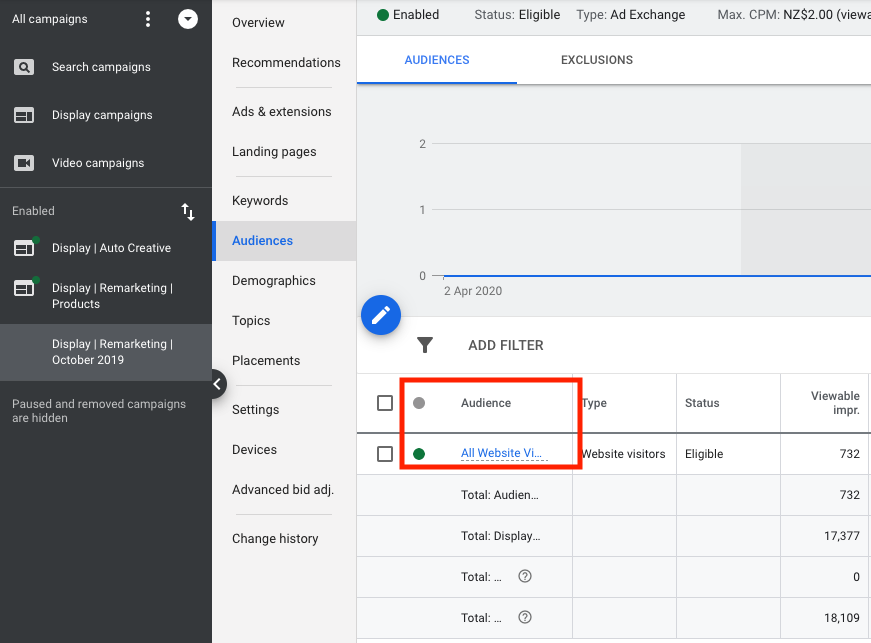In This Lesson You Will Learn How To Build Audience Types
The purpose of this lesson is to help you improve your knowledge about the various Google audience targeting options available in order to reach your ideal audience for your Google Ad campaigns.
How To Create a Custom Intent Audience List

Different Types Of Audiences
Audience Targeting Is Critical To The Success of Your Campaigns
Audience targeting options allows you to be more accurate when choosing who sees your ad. Certain audience groups have specific interests, intents and demographics as estimated by Google.
- Audience targeting is the method of separating consumers into segments based on interests or demographic data. Marketers should use audience targeting to formulate campaigns that will align directly with their consumers' lifestyles.
- The key to successful online advertising is understanding your potential customer’s intent and matching it to the type of ad they see. Following is a list of most common audience groups. The first audience group is Demographics.
Demographic Groups
With demographic targeting in Google Ads, you can reach customers who are likely to be within the demographic groups you choose. You’re able to choose the age, gender, parental status, or household income of the audience you want to reach.
- You may also exclude any specific demographic groups to make your advertising more efficient.
- Bare in mind excluding any demographic categories can significantly decrease the amount of traffic your ad group or campaign might receive.
- As you can see in the example screenshot, the 35 - 44, 45 - 54 and 55-64 age groups have been included.
Affinity Audiences
Affinity audiences permit you to raise brand awareness and drive consideration with your ads by reaching people who already have a strong interest in relevant topics. Affinity audiences is a broad content category.
Google takes into account a user's browsing history, time on pages visited and then associates an interest category within the users browser.
- Rather than looking at one particular purchase intent (like in-market audiences) Affinity targeting analyses someone’s overall interests, such as passion and lifestyle, to get a sense of general identity. These users are higher in the purchasing funnel at the beginning of the process
- In the example screen shot we have chosen to target Avid business news readers and business professionals
In-Market Audiences
In-market audiences allow you to target consumers who are researching products and actively considering buying a service or product like those that you offer.
These audiences are designed for advertisers focused on getting conversions from likely buyers. In-market audiences can help drive remarketing performance and reach consumers close to completing a purchase.
- Note these users are lower in the purchasing funnel near the end of the process.
- In this particular example we have chosen several categories to target including Arts & Craft Supplies and Beauty Products & Services.
Remarketing
Remarketing is a way to connect with people who previously interacted with your website or mobile app.
It allows you to strategically position your ads in front of these audiences as they browse Google or its partner websites, thus helping you increase your brand awareness and stay connected with your target audience with the goal of enticing them back to your website and converting them into a customer.
- Greater brand awareness inevitably leads to higher conversion rates and that means a faster return on your investment and a lower cost per sale. In this particular case we have chosen to target all visitors to our website over a certain time period.
Custom Intent Audience
This audience group is for Display and Video campaigns only. You can use custom intent audiences with auto-created audience segments as defined by Google, or you can define your own audiences by entering the keywords of your choosing.
- Now bare in mind the beauty of custom intent audiences is that it allows you to expand outside of pre-defined audience categories.
- You can reach your ideal audience by segmenting ad groups according to specific keywords you want to target.
Life Events
Life event targeting reaches potential customers when they are going through a major life milestone. For example, purchasing a new home, a job change, marriage or retirement.
Life event targeting is a valuable option to reach consumers at prominent moments in their lives.
Within the Google platform, anybody can target a user based on age and gender, but adding a life event can set you apart from your competitors.
- Previously, the best way to engage with consumers who are researching and considering a purchase was via Google ads by targeting the right high-intent keywords.
- A person’s search history, including the videos they watch, can be very revealing and even predictive.
- Thanks to machine learning, Google is now better able to understand user traits and estimate their intent.
If you are having an issue, we can help. Please get in touch.
Yes. With Custom Affinity Audiences, you can create your own segment to target the specific audience you want to reach.
Yes. For most campaign types you can choose countries, cities or even your Google My Business locations for your ads to show.
Yes. Audience insights is designed to help you find new audiences by showing valuable information about the people in your remarketing lists.